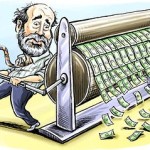 The current bullish global stock market since Mar 2009 has been 5 years as of now (Mar 2014), comparable with the maximum 5 years duration of bull market in the last market cycle (Dow Jones Index from valley of Oct 2002 till Oct 2007). It is likely for the current market cycle to be much longer than the previous ones because there are major corrections along the way, limiting the increase in % market optimism, therefore lower risk in reversal into a mega bear market.
The current bullish global stock market since Mar 2009 has been 5 years as of now (Mar 2014), comparable with the maximum 5 years duration of bull market in the last market cycle (Dow Jones Index from valley of Oct 2002 till Oct 2007). It is likely for the current market cycle to be much longer than the previous ones because there are major corrections along the way, limiting the increase in % market optimism, therefore lower risk in reversal into a mega bear market.
In the last Global Financial Crisis in 2009, the world #1 economy, US, adopted extraordinary measures of Quantitative Easing (QE1, QE2, QE3) and near-zero interest rate by the Fed. As a result, the US and global markets were artificially recovered, forming the phase1 of bull market in the initial first 2 years. However, the double-edge sword of QEs made the global market pay for the advance credits during the QE tapering process, resulting in a few rounds of market corrections, together with other regional financial crisis. At the same time, the global economy (US, Europe, Asia) recovers gradually, in a more natural way to support the global stock market.
At this junction, before the peak of stock market or economy may be reached, QE3 must be tapered and completely stopped, so that a more natural market cycle can be formed. Either introduction of QE during a bearish market or tapering of QE during a bullish market, gives confidence to the global investors. The Fed has done a good job to pre-alert the global investors with a few rounds of fire drills last year on the possible timeline of QE3 tapering. The market reacted fearfully initially, then it becomes a norm, most investors are able to “predict” $10 billion per month of QE3 tapering after each FOMC meeting by the Fed. Meanwhile, the US economy recovery was accelerated, approaching the psychological checkpoint of 6.5% unemployment rate while the inflation rate is still well below the critical 2.5%.
With the initial success in QE3 tapering, now the Fed hopes to apply the same strategy to alert the global market on timing of interest rate hike (investors like a predictable market). After a few rounds of pre-conditioning in near future, global investors are likely to accept the fact that interest rate has to go up from the valley. Besides, the Fed hopes to buy more time for change in bullish market sentiment, modifying the earlier criteria of 6.5% US unemployment rate and 2.5% inflation rate, to a larger group of economic indicators, to ensure a more sustainable and stronger sign of economy growth.
After QE3 is fully stopped (estimated in year 2014 if there is no surprise to the market), the Fed is expected to increase the interest rate in about 6 months later. The Fed interest rate will chase after the 10-year US Treasury Bond yield, likely will take about 3-5 years (average of about 1%/year, depending on economic conditions) to catch up and even exceed the critical rate of 4%, when the peak of economy may start to form.
If the global stock markets continue to grow in a bumpy way with market corrections from time to time, the condition for market fever with >75% optimism may not be ready, then it is possible to have a super long (over 7-10 years) but gradual growth bull market. It is critical for investors to position themselves with visibility of at least next 3 years, applying the preferred market strategy.
